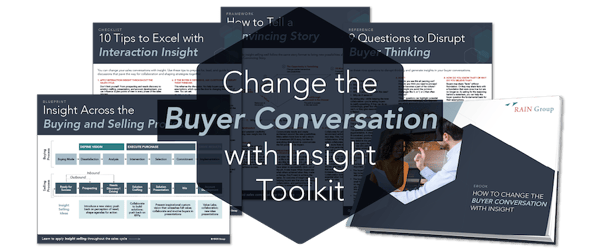When it comes to business development for professional services, one of the biggest challenges professionals face is finding time to do it all. After all, you don't sell full-time. Your work, whether it's consulting, accounting, IT, financial services, or engineering, is what you do full-time. It can be very difficult to find time to create and develop the relationships necessary to bring in new business.
Many professionals feel there simply are not enough hours in the day to do it all.
As a result, business development activities are unplanned and inconsistent, which leads to limited touches and prospects slipping through the cracks due to lack of follow-up.
While I cannot create more hours in the day, I can give you some business development tips that will help you become more effective with the balancing act of selling and doing.
Why Is Business Development Important?
Many professionals have the mindset that they don’t need to concern themselves with business development. There’s a common belief that your work should speak for itself. Often, professionals receive little guidance on business development, if any.
While it would be ideal to grow business based on reputation alone, this isn’t usually how it works out. Competition is fiercer than ever. Professionals need to differentiate themselves and assert their value in an environment saturated with information.
Professionals who succeed don’t just wait for opportunities to come to them. While others are scrambling to recover when sales dry up, the most successful professionals are constantly working to bring in new clients and expand their key accounts. They actively build their pipelines and ensure a predictable flow of revenue.
And when you sell your organization’s full capabilities, you uncover opportunities for your clients they otherwise might not have known about.
Business Development Strategy
Your approach to business development is highly dependent on your role and industry. However, a good place to start with strategy is by defining your goals.
Your goals should be both short- and long-term and they should be measurable. Say you’re looking to keep your pipeline full. Your success metrics might be the number of meetings you set with prospective clients.
From there, you can figure out how much outreach is necessary to land a meeting and map out your prospecting activities. These are the actionable steps you take in pursuit of your goal. With business development, you’ll often need to plan for more than one type of action. For instance, researching prospective clients, developing an outreach campaign, or attending events would also contribute.
Half of a good business development strategy is committing to a plan. The other half is knowing how to execute—and these 6 tips can help keep you accountable and consistent.
 Make a plan and commit to it. Learn how to set and reach your business development goals with our Goal-Setting Worksheet.
Make a plan and commit to it. Learn how to set and reach your business development goals with our Goal-Setting Worksheet.
6 Business Development Tips
1. Do a Little Bit Every Day
The excuses for not selling are plentiful: I was busy delivering, I had to run a report, a meeting went long—the list goes on. There’s always something else. To be successful, you must make business development a priority, and you can start by setting aside a little bit of time every day to focus on your sales efforts.
Mornings tend to work best, before you get caught up in the hustle and bustle of the day. Block this time off in your calendar, close your door, and don't allow any interruptions. This is your sacred selling time.
2. Focus on Efforts That Offer the Best Chance of Success
Know where to spend the sacred selling time you have. Often, it takes just as much time and effort to sell a $25,000 deal as it does to sell a $125,000 deal. Focus on deals that have the greatest potential for long-term success.
In The 7 Habits of Highly Effective People, Steven Covey writes, "Put first things first." He suggests focusing on work that is less urgent but more important to your long-term goals.
Apply that thinking to your business development efforts. Know where the highest potential is and focus on those prospects first.
3. Make Action a Priority
How many times have you thought, "I should really give Jim Smith at ABC Manufacturing a call to follow up on our conversation from last week, but I don't have time right now. I'll do it later."
Later never comes.
When you think about doing something, do it (or at least set a reminder to do it during your sacred selling time). Half of selling success is just showing up and doing it, yet so many professionals get caught up in their other work and don't do essential sales work.
4. Leverage Your Resources—Both People and Technology
Make your life easier by delegating when possible. Do you need to write the proposal and follow-up materials or can a junior staffer or virtual assistant sit in on the sales meeting and write the first draft? Do you need to write follow-up emails after you speak at an event or can you hand this off to a marketing team member?
When you leverage your resources well, you can get more done for your clients and prospects and create more time to focus on business development and relationship building. Resources don’t just include people; technology has come a long way to help you become more efficient.
Automate some of your lead nurturing by sending emails that provide valuable insights to prospects. Connect with prospects and clients on LinkedIn and Twitter. Publish a blog and post regularly. These technologies can help you build and strengthen your relationships. They also help you stay top of mind with clients and prospects, so when the need arises, you’re the first one they think of.
5. Keep Efforts Organized
Business development can be a daunting task when you don’t keep all your contacts, leads, and activities in the same place. To make your sacred selling time most effective, use a CRM tool to keep track of your sales conversations.
Take good notes. At the end of each conversation, set a solid next step for yourself and record this in your CRM. This will help you stay organized and prioritize your follow-up and sales efforts.
6. Build Your Business Development Skills
If you’re a consultant, accountant, engineer, or other professional service provider, you likely came up through the ranks building knowledge around your technical skills or area of focus. Perhaps you’ve had very little business development training and you’re not comfortable with it.
But I have a secret to share with you. The skills that make you a great service provider to your clients are also the skills that can make you great in sales. You just need to know how to apply those skills.
RAIN Group has worked with hundreds of global and regional professional services firms to help them build business development skills, develop a culture of business development success, and grow their accounts.
Learn more about business development training for:
The Impact of Business Development
Stop stressing out about your long to-do list. Follow these business development tips, and your days could look something like this:
It's Friday morning and you've blocked off three hours for uninterrupted sales time. You sit down at your computer, and an alarm goes off instructing you to call back Jessica Smith of Smith & Jones Manufacturing, whom you met at an industry event two weeks ago.
You open up your contact management system, peruse your notes, and see that Jessica is a Boston Celtics fan. You pick up the phone and call her, making a point to congratulate her on her team's recent win.
The conversation continues, and you mention how you read a Harvard Business Review article that relates to the manufacturing industry. When the conversation ends you set a task in your calendar to follow up with Jessica next month. There's no immediate need, but you know you can help Jessica's business be more successful in the long term. Using your CRM, you add her to your e-newsletter list and send a quick email to one of your associates, asking him to retrieve the article from HBR and send it to Jessica.
You move on to the next person on your list. By the time noon rolls around, you've moved four leads forward and left messages for ten others.
This afternoon, you're off to deliver that big consulting project you've been working on all month.
The result: your sales efforts are consistent and organized. You're developing relationships and moving prospects to the next stage of the pipeline. And it's all because you made the time and added selling to your priority list.






